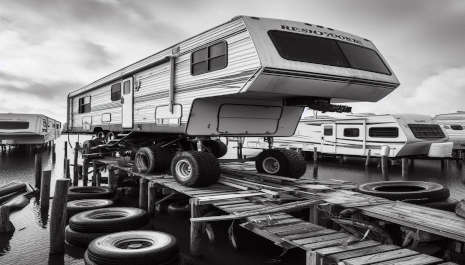By Murray Wennerlund published 11-16-2024 updated 11-16-2024
|
|
|

By Murray Wennerlund published 12-16-2022 updated 11-9-2024

By Murray Wennerlund published 12-16-2022 updated 11-9-2024
Flood Insurance Requirement for Recreational Vehicles
Recreational Vehicles (RVs) may include motorized vehicles (i.e., Class A, B, or C vehicles, or motorhomes) and travel trailers (e.g., fifth wheel, pop-up camper, etc.).
Generally, motorized vehicles are not insurable as property by the NFIP. Applicants whose primary residence is a motorized vehicle are exempt from the requirement to obtain and maintain flood insurance and may be eligible for IHP assistance, even if they received IHP assistance for flood-damaged personal property in a previous disaster.
RVs without wheels, built on a chassis, and affixed to a permanent foundation (referred to as “travel trailers”) are insurable under the NFIP. Applicants located in an SFHA, who previously accepted IHP assistance for a flooding incident and whose primary residence is a travel trailer, are required to obtain and maintain flood insurance for as long as the address exists for at least the amount of flood-damaged IHP assistance received for real and/or personal property.
Applicants with a NFIRA requirement, who fail to affix a travel trailer to a permanent foundation and/or to properly elevate the travel trailer in compliance with the community’s floodplain management requirements, rendering the unit uninsurable under NFIP, will be ineligible to receive any Federal assistance for flood-damaged real or personal property in a future disaster.
Non-Traditional Housing
One commenter stated that FEMA does not recognize applicants who live in non-traditional housing such as “boats, yurts, and travel trailers.” The commentor requested that FEMA consider these as viable places of residence and recognize them for compensation.[Resource]
Per Chapter 3: II.B. 10. of IAPPG 1.1, eligible applicants who live in travel trailers and boats may be eligible for Home Repair Assistance and Home Replacement Assistance. Applicants residing in yurts and other unique homes may also receive Home Repair Assistance for any damaged structural elements of the home. However, Home Repair Assistance and Home Replacement Assistance is not available for other non-traditional forms of housing if they do not have structural elements to assess and calculate a repair or replacement award (e.g., tents). By policy, FEMA defines non-traditional housing as a form of dwelling void of structural floor, structural walls, and structural roof. Applicants who reside in non-traditional housing who are able to verify occupancy may be eligible for initial Rental Assistance, Lodging Expense Reimbursement, and all types of Other Needs Assistance.
Home Replacement Assistance: (Resource FEMA Individual Assistance Regulation Implementation IAPPG Amendments 3.22.24)
As mentioned above, through the regulatory update, FEMA has updated its definition of uninhabitable and sanitary. As such, FEMA has eliminated the previous requirement that Home Repair Assistance and Home Replacement Assistance could only be provided for disaster damaged components that were functional prior to the disaster. Instead, FEMA may now provide Home Repair Assistance and Home Replacement Assistance for disaster damaged components that may have had pre-existing conditions that were further impacted by the disaster. The following replaces Chapter 3, Section IV.G. of the IAPPG 1.1 in its entirety.
FEMA may provide financial assistance to homeowners whose primary residences were destroyed as a result of a Presidentially-declared disaster. FEMA defines “destroyed” as the primary residence is a total loss or damaged to such an extent that repairs are infeasible. Home Replacement Assistance may be applied toward purchasing a new permanent residence even if the new residence’s cost is greater than the financial Housing Assistance maximum award.
FEMA calculates the replacement award amount based on average replacement costs established by FEMA for the type of residence destroyed. However, the award amount cannot exceed the financial Housing Assistance maximum award.
Conditions of Eligibility:
In addition to meeting general conditions of eligibility established in IAPPG 1.1, Chapter 3, Section II, applicants must meet the following conditions in order to receive Home Replacement Assistance:
A FEMA inspection confirms the residence was destroyed and some damage was caused by the disaster. FEMA considers a residence destroyed when:
Research Resources: